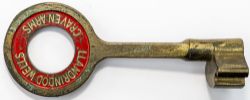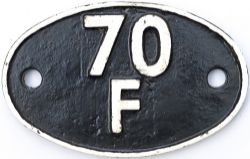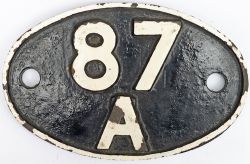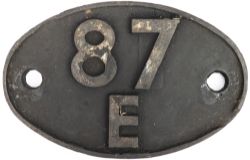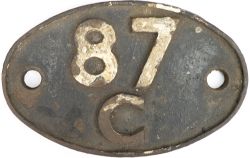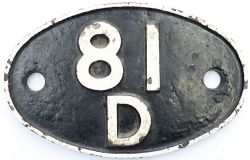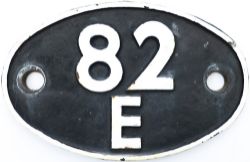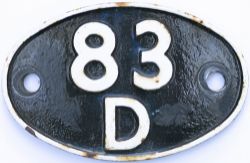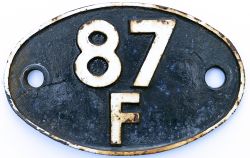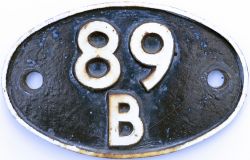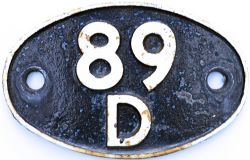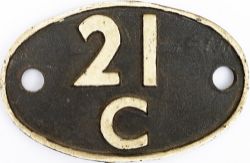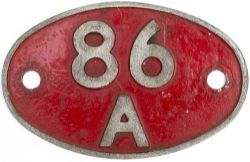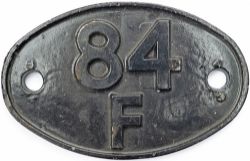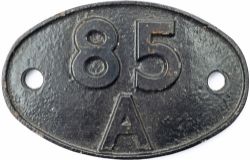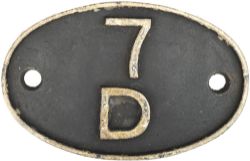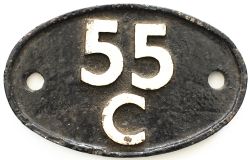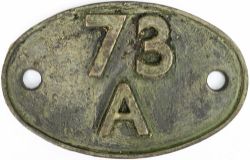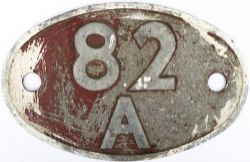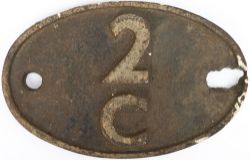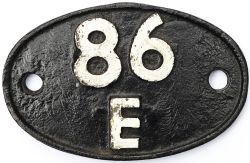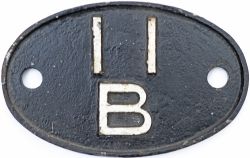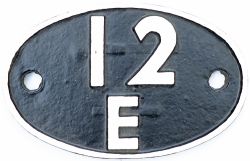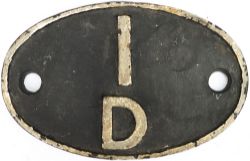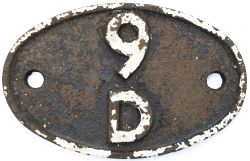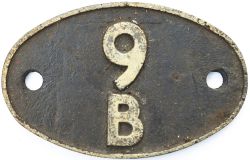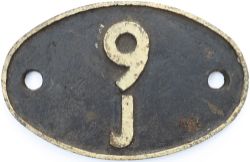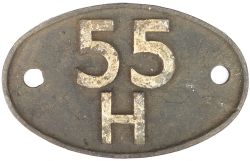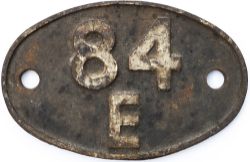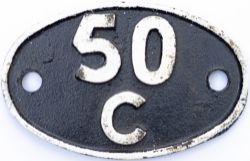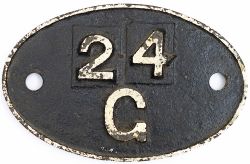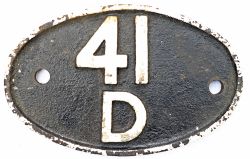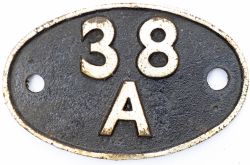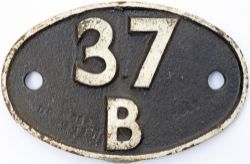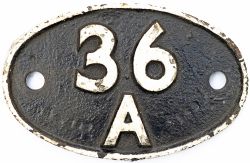You need to be registered and approved to bid at this auction.
Watch the auction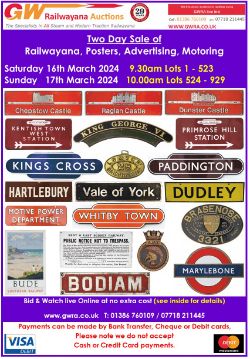
This is a Live Internet auction only
IF YOU LAUNCH THE LIVE BIDDING APP AND HAVE PROBLEMS VIEWING THE LIVE SALE, PLEASE DELETE YOUR EMAIL AND PASSWORD AND RE ENTER MANUALLY DO NOT USE AUTOFILL
If you have any issues trying to register please contact Auction Technology Directly as we haven’t got any access to your details.
support@auctiontechnologygroup.com
It is important that you sign up through our link not through the-saleroom.com directly as the point of sign up attracts different commissions.
|
Auction currency
|
GBP |
|
Accepted cards for registration
|
|
|
Accepted cards for payment
|
|
|
Other payment methods
|
BR-W Tyers No9 single line aluminium key token BARMOUTH NORTH - HARLECH, configuration D. In restored condition measures 7.5in long.
BR-W Tyers No9 single line aluminium key token BORTH - ABERYSTWYTH, configuration D. In ex railway condition measures 7.5in long.
BR-W Tyers No9 single line aluminium key token TENBY - PEMBROKE, configuration B. In ex railway condition measures 7.5in long.
BR-W Tyers No9 single line aluminium key token BALA - BALA JUNC, configuration A. In ex railway condition measures 7.5in long.
BR-W Tyers No9 single line aluminium key token PORTMADOC - CRICCIETH, configuration A. In ex railway condition measures 7.5in long.
BR-W Tyers No9 single line aluminium key token TOWYN - LLWYNGWRIL, configuration D. In ex railway condition measures 7.5in long, note this has been converted whilst in railway use from the original configuration of B for this section.
BR-W Tyers No9 single line aluminium key token GOBOWEN SOUTH - OSWESTRY NORTH, configuration A. In ex railway condition measures 7.5in long.
BR-W Tyers No9 single line aluminium key token BUTTINGTON CROSSING-WESTBURY, configuration A. In ex railway condition measures 7.5in long.
BR-W Tyers No9 single line aluminium key token KNIGHTON NO 2 - LLANGUNLLO, configuration A. In lightly restored condition measures 7.5in long.
BR-W Tyers No9 single line aluminium key token POOL QUAY - LLANYMYNECH configuration A. In lightly restored condition measures 7.5in long.
GWR Tyers No9 single line steel key token with brass plates either side JOHNSTON - NEYLAND, configuration C. In ex railway condition measures 7.5in long.
GWR Tyers No9 single line steel key token MOAT LANE JUNC WEST - CAERSWS, configuration A. In lightly restored condition measures 7.5in long.
GWR Tyers No9 single line steel key token TALERDDIG - LLANBRYNMAIR, configuration A. In lightly restored condition measures 7.5in long.
Tyers No9 single line steel key token CAERSWS-CARNO configuration B. In ex railway condition measures 7.5in long.
LMS Tyers No9 single line bronze key token LLANDRINDOD WELLS - CRAVEN ARMS configuration A. In ex railway condition measures 5.75in long.
BR-W Tyers No9 single line aluminium key token TALERDIGG - MACHYNLLETH, configuration B. In ex railway condition measures 7.5in long.
Tyers No9 bronze single line Key Token MEDSTEAD - ALRESFORD configuration D. From the former London & South Western Railway line closed in 1973 and then reopened as the Mid Hants Railway. In ex railway condition measures 5.75in long.
Shedplate 70F Fratton April 1955 to November 1959, then Bournemouth September 1963 to July 1967.The ex LBSCR and LSWR joint shed housed just twenty locos while using this code. Ex LSWR shed Bournemouth was home to 40 locos including 7 Bullied Light P acifics and 9 Merchant Navies. In lightly face restored condition with the BR(S) Eastleigh triangle cast into the back and typical Southern region casting marks on the front.
Shedplate 87A Neath 1949-June 1965. This ex GWR shed was home to 60 locos during the 1950s. In its final few months this had dwindled to just 10.Face restored rear original.
Shedplate 87E Landore 1949-closed to steam June 1961. This ex GWR shed had 70 locos on its books at the end of the 1950s, which included 20 Castles. In original condition and 88A painted on the rear showing it was reused at some point.
Shedplate 87C Danygraig 1949-January 1960 for steam, March 1964 totally. This ex R&SBR shed was home to an exotic collection of pre-grouping tank engines throughout it BR days when its total allocation was never more than 30 locos. In original c ondition with clear Swindon casting marks in the edge and rear.
Shedplate 75C Norwood Junction 1950-January 1964 to steam, small allocation of diesel shunters until closure in 1966 In early BR days this ex SR shed had 40 locos, which was reduced to 18 in its final year. A small fleet of diesel shunters also carri ed this code; 3 03s, 15 08s and 3 of their SR forerunners. In lightly cleaned condition with the BR(S) Eastleigh triangle cast into the back and typical Southern region casting marks on the front.
Shedplate 81D Reading 1948 to January 1965. This ex GWR shed had 90 locos in the 1950s including a handful of Castles and around 20 Halls. Face lightly restored with clear Swindon casting marks to rear and edge.
Shedplate 82B St Philips Marsh 1950 to June 1964. This ex GWR shed in Bristol had a substantial allocation of over 140 locos in the 50s, including a large number of Halls and Granges. Face lightly restored with clear Swindon casting marks to rear an d edge.
Shedplate 82E Yeovil Pen Mill 1949-February 1958, then Bristol Barrow Road February 1958-November 1965. The ex GWR shed at Yeovil housed just 10 locos during this period. It was transferred from the WR to the SR becoming 71H, finally closing in Janua ry 1959. The ex Midland shed at Barrow Road, Bristol was transferred from the MR 22A to the WR in 1958. At this time its allocation of around 50 locos included 3 Patriots and 9 Jubilees. However, by 1965 the depot had been westernised with an allocation that included 11 Halls and 2 Granges in its total of 40 locos. Face restored with clear Swindon casting marks to the edge.
Shedplate 83D Plymouth Laira 1949-September 1963, recoded 84A, closed to steam April 1964. This ex GWR depot had between 80 and 100 locos during the period it used this code. At one time it had 18 Castles, 3 Counties, 1 star, 11 Halls, 2 Granges , 4 Manors and last but not least, 10 Kings. It was also home to Class 41/43 Warships and Class 52 Westerns, many being noted carrying these cast iron steam codes. Face restored and a later pattern so may have been carried on one of its early Hydraulics.
Shedplate 87F Llanelly 1949 to October 1965. This ex GWR shed housed 90 locos in the 50s, and during its BR life it had a sprinkling of Halls and Granges. Its final year's allocation of 22 included 3 ex LMS 8F 2-8-0s. Face restored with clear Swindon casting marks in the edge and rear.
Shedplate 88B Cardiff East Dock 1949 - March 1958, then Radyr October 1960-July 1965. The former GWR depot at East Dock was home to 60 locos in the 1950s which included an exotic collection of antiquated tank engines. The depot was run down and los t its allocation in 1958, but was to rise from the ashes in September 1962, now coded 88L, when it inherited all of Cardiff Cantons steam allocation; Castles, Halls, Granges and Manors now graced the shed. Ex GWR shed Radyr had taken this code over in 1960 which had around 50 locos during this period. Face restored with clear Swindon casting marks in the edge and rear.
Shedplate 89B Brecon 1949-November 1959. This ex B & M shed lost its allocation of 13 locos in November 1959 and became a sub shed of 89A Oswestry. For some reason the WR authorities decided to recode it 88K in January 1961, but no engines were e ver allocated! It remained open until December 1962. In restored condition, with clear Swindon casting marks to the edge.
Shedplate 89D Oswestry September 1960-September 1963. During the time this ex Cambrian Railways shed used this code it had an allocation of around 40 locos. Formerly 89A, Oswestry came under the LMR in September 1963 when it became 6E; a code it used for just three months prior to closure in January 1964. In restored condition with clear Swindon casting marks in the edge and rear.
Shedplate 21C Bushbury 1960 - 1963. This ex This ex LNWR shed was originally coded 3B and closed to steam in April 1965. Lightly face restored.
Shedplate 86A Cardiff Canton 1963-1973. This aluminium code was used by diesel hydraulic and diesel electric locos. In lightly cleaned condition.
Shedplate 85D Kidderminster 1949-September 1960 then Bromsgrove September 1960 to September 1964. Ex GWR shed Kidderminster housed 20 locos in the 1950s, and then Bromsgrove, ex LMS shed 21C, then 85F adopted the code and had 17 locos allocated in e arly 1964. Partially face restored with clear Swindon casting marks.
Shedplate 84F Stourbridge Junction 1949-September 1963. This ex GWR shed was home to 85 locos in the 1950s, but by the time it was taken into the LMR as 2C in 1963 this number had dwindled to 35. The shed finally closed in July 1966. Partially face r estored with clear Swindon casting marks.
Shedplate 85A Worcester 1949-December 1965. This ex GWR shed was home to 80 locos in the 1950s, including Bulldogs, Stars, Castles, Halls and Granges. Even in its final year it hosted 6 Halls and 5 Granges in a total of 24 locos. Partially face resto red with clear Swindon casting marks.
Shedplate 7D Rhyl 1935 to May 1952. This ex LNWR shed was home to 27 locos in 1950. It was recoded 6K and finally closed in February 1963. A rare and early LMS pattern plate the first time this pattern has been offered in auction.
Shedplate 55C Farnley Junction October 1956-November 1966. This ex LNWR shed was transferred from the LM region 25G in 1956, when all 50 locos received this code. In its final year it had just 5 Black 5s, a solitary 8F, and 3 Jubilees. Lightly face r estored.
Shedplate 73A Stewarts Lane 1950 to June 1962. This ex SECR shed had an allocation of over 100 locos during this period. Of note were 7 King Arthurs, 6 Schools 13 Bullied Light Pacifics and 3 Merchant Navy's. In June 1962 it was recoded 75D, and lost its steam allocation in September 1963. It is still a Repair and Maintenance depot for diesel and electric locos and a servicing point for steam locos. In lightly cleaned condition with the BR(S) Eastleigh triangle cast into the back and typical Southern region casting marks on the front.
Shedplate cast aluminium 82A Bristol Bath Road. This aluminium code was used by diesel hydraulic and diesel electric locos. In original condition but with some white paint around the edges.
Shedplate 2C Warwick Milverton 1950-November 1958, then Stourbridge Junction 1963-July 1966. The ex LNWR shed at Warwick had a small allocation of around 15 locos in the 1950s, and when the ex GWR shed at Stourbridge was absorbed into the LMR taking over this code, it maintained over 30 locos. In good original condition.
Shedplate 86E Severn Tunnel Junction 1948 to October 1965 for steam. This ex GWR shed was home to around 75 locos in the 1950s. In face restored condition with correct Swindon casting marks to rear and edge.
Shedplate 11A Carnforth 1948-April 1958, then Barrow-in-Furness April 1958-June 1960. The ex LNWR shed at Carnforth was home to around 40 locos in the 1950s. The ex FR shed at Barrow had 50 locos in the short while it used this code. Face restored.
Shedplate 11B Barrow 1935 to April 1958, then Workington April 1958 to May 1960. The ex Furness Railway shed at Barrow had 50 locos when using this code and the Ex LNWR shed Workington had 30 when using this code. An early style casting in lightly re stored condition.
Shedplate 12E Moor Row 1948-July 1954, then Kirkby Stephen February and March 1958, then Barrow in Furness June 1960-September 1963, and finally Tebay September 1963-January 1968. The ex FR/LNWR shed at Moor Row housed 12 locos. Ex NER Kirkby Stephen had 11 locos, while ex FR Barrow in Furness had 45. However, this code is usually associated with the 9 Tebay allocated bankers that assisted trains over Shap. Face restored.
Shedplate 1D Devons Road Bow 1949-August 1958 for steam, total closure October 1964. This ex NLR shed had an allocation of 50 in 1950. It became the first diesel only depot on the system; a number of the new diesels also carried this code. In origina l condition.
Shedplate 9D Buxton 1935 to September 1963, then Newton Heath September 1963 to February 1968. The ex LNW shed at Buxton had 55 locos in the 1950s, before becoming 9L. The ex LYR shed at Newton Heath, formerly 26A, had 80 locos on its books. In origi nal condition.
Shedplate 9B Stockport Edgeley 1935-May 1968. The ex LNWR shed at Stockport housed only 25 locos in the 1950s, but this increased to 35 during the twilight of steam in the 1960s. Most famous resident was undoubtedly the double chimney Jubilee 45596 B ahamas. In original condition.
Shedplate 9J Agecroft September 1963-October 1966. This ex LYR shed, formerly 26B housed just 25 locos when using this code. In original condition.
Shedplate 55H Leeds Neville Hill January 1960-June 1966 for steam. This ex NER shed, formerly 50B, had around 20 steam locos using this code in the 1960s. Its large allocation of DMUs also used these plates. In as removed condition.
Shedplate 84E Tyseley 1949-September 1963. This ex GWR depot had well over 100 locos on its books during the time it used this code. It was transferred to the LMR and became 2A, finally closing to steam in November 1966. In original condition with ty pical Swindon casting marks.
Shedplate 50C Selby 1948-September 1959, then Hull Botanic Gardens January 1960-1973. The ex NER shed at Selby had 60 locos allocated during this period. Hull Botanic Gardens, another ex NER shed, became a purpose built diesel maintenance facility, a nd many DMU vehicles and locos carried this code. Face restored.
Shedplate 24G Skipton February 1957 to September 1963. This ex MR shed had 24 locos when using this code. This is an earlier LMS style casting. Lightly face cleaned.
Shedplate 71A Eastleigh 1950-September 1963. This ex LSWR shed housed eleven King Arthurs and eight Lord Nelsons among its 1950 allocation of 140 locos. By the time it changed code to 70D in 1963, fifteen West Country pacifics were present in a total of 100 locos. Closure to steam came in July 1967. In lightly restored condition with the BR(S) Eastleigh triangle cast into the back and typical Southern region casting marks on the front.
Shedplate 41D Canklow February 1958-October 1965. This ex Midland shed was transferred from the LMR 19C to the ER in 1958 when it maintained nearly 50 locos. By 1965 it was still looking after 27 freight locos. Face lightly restored rear original.
Shedplate 38A Colwick 1949-February 1958. This ex GNR shed housed 200 locos in the 1950, which at one time included 4 B17 Footballers! It was recoded 40E in 1958 and transferring to the LMR in January 1966, it became 16B. It closed to steam in Decemb er 1966, and completely in April 1970. Face lightly restored rear original.
Shedplate 37B Copley Hill 1949-October 1956. This ex GNR shed had 40 locos in the early 1950s, which included 5 A3s and 10 A1s. It was recoded 56C and closed in September 1964. Face lightly restored rear original.
Shedplate 36A Doncaster 1949-May 1966 to steam. This ex GNR shed had a handful of A3s and B1 Antelopes and Directors in its 1950 allocation of over 180 locos. By the end of steam it had also hosted 13 A1s and the ever present V2 namer 60872. Face lig htly restored rear original.
BR(W) carriage board KINGSWEAR MANCHESTER. In good condition complete with metal ends, measures 132in x 5in.
BR(S) Carriage Board GATWICK AIRPORT SERVICES. Wood complete with original metal ends. In very good condition measures 31in x 4.25in.
Confirming your bid is a legally binding obligation to purchase and pay for the lot should your bid be successful.
Confirming your bid is a legally binding obligation to purchase and pay for the lot should your bid be successful.














